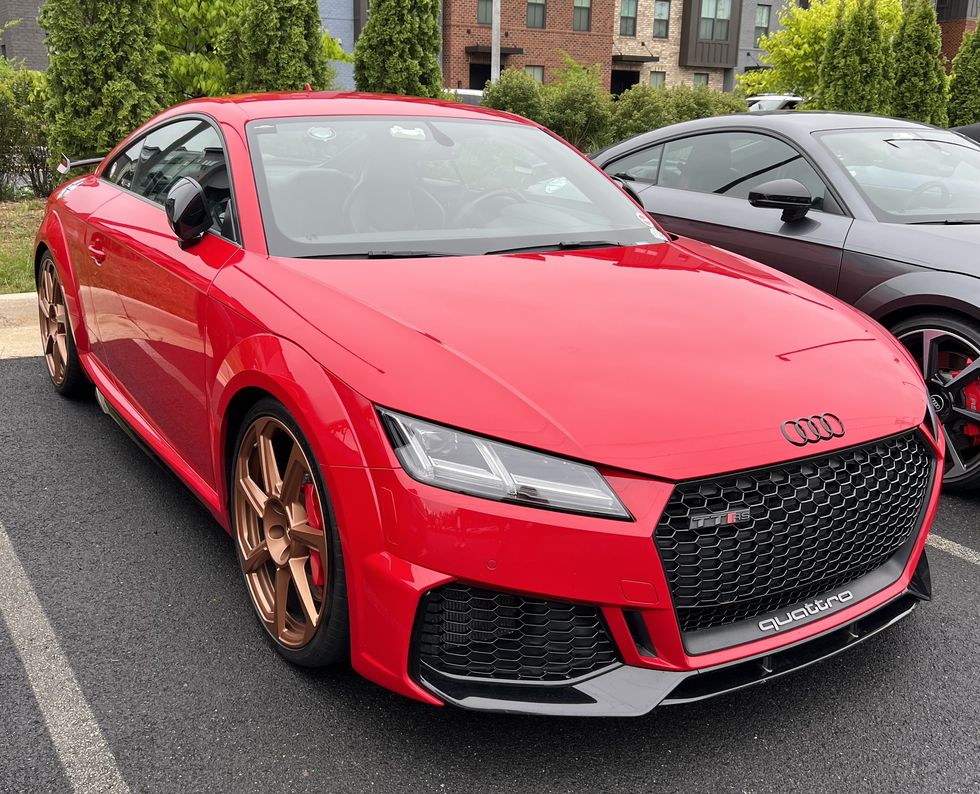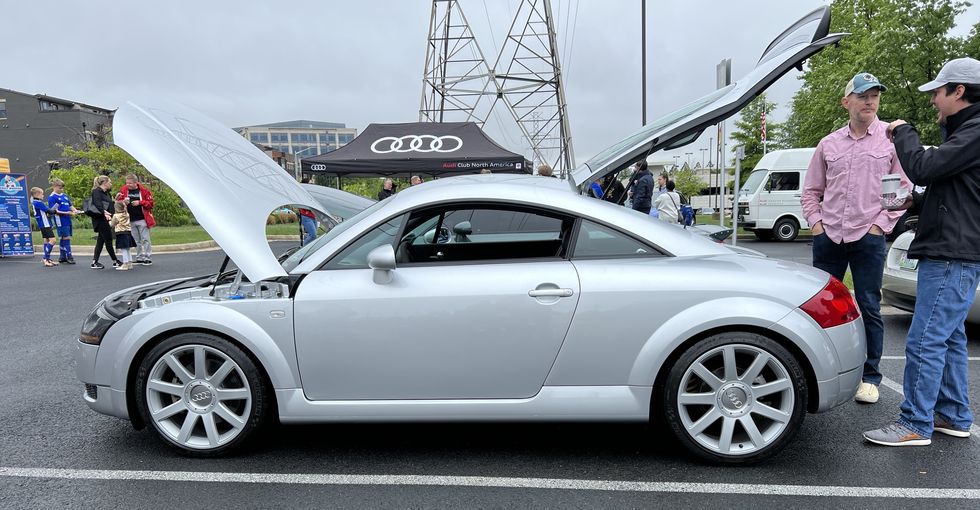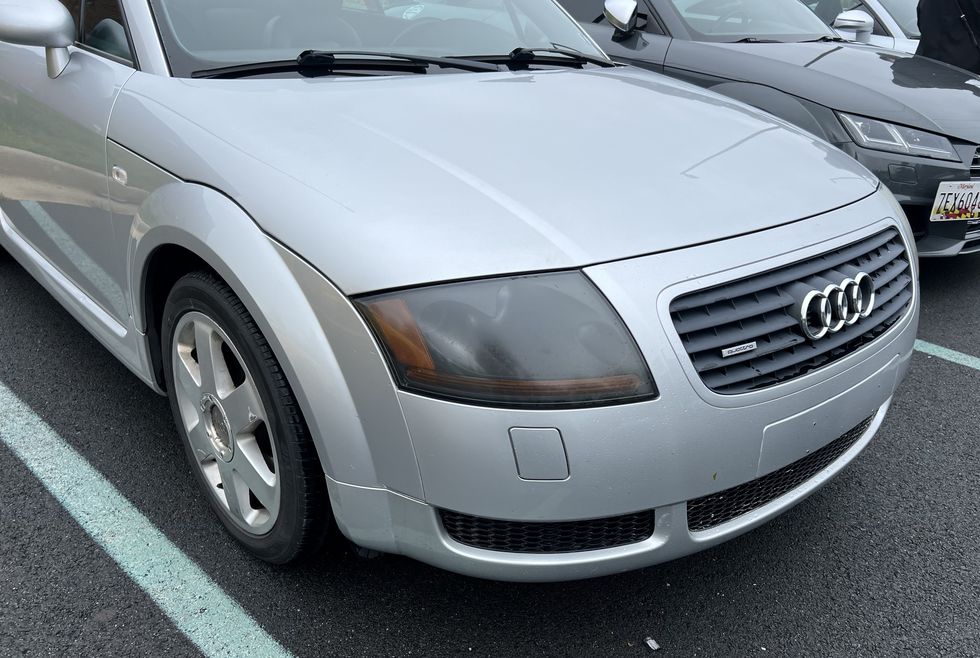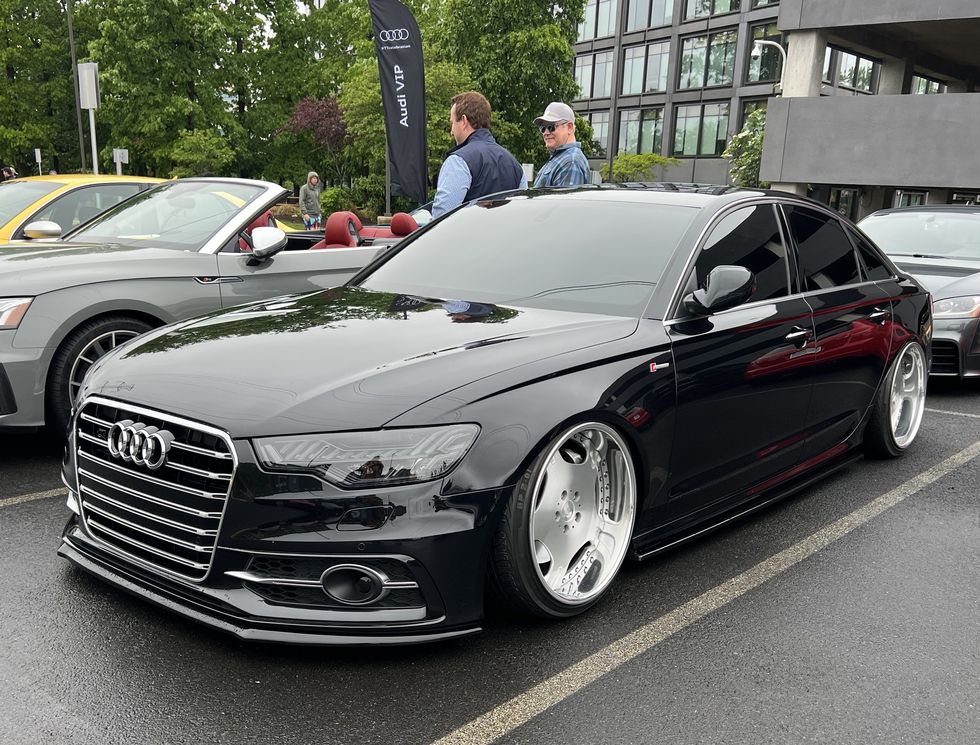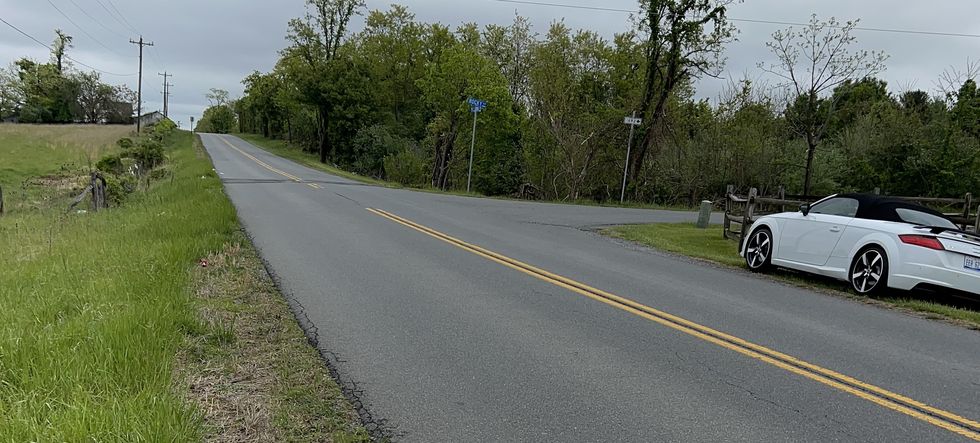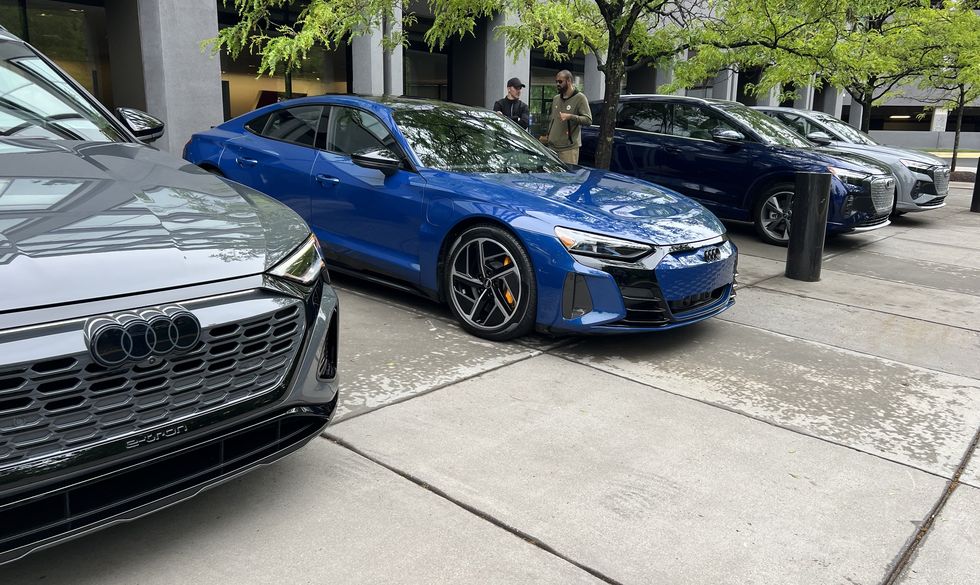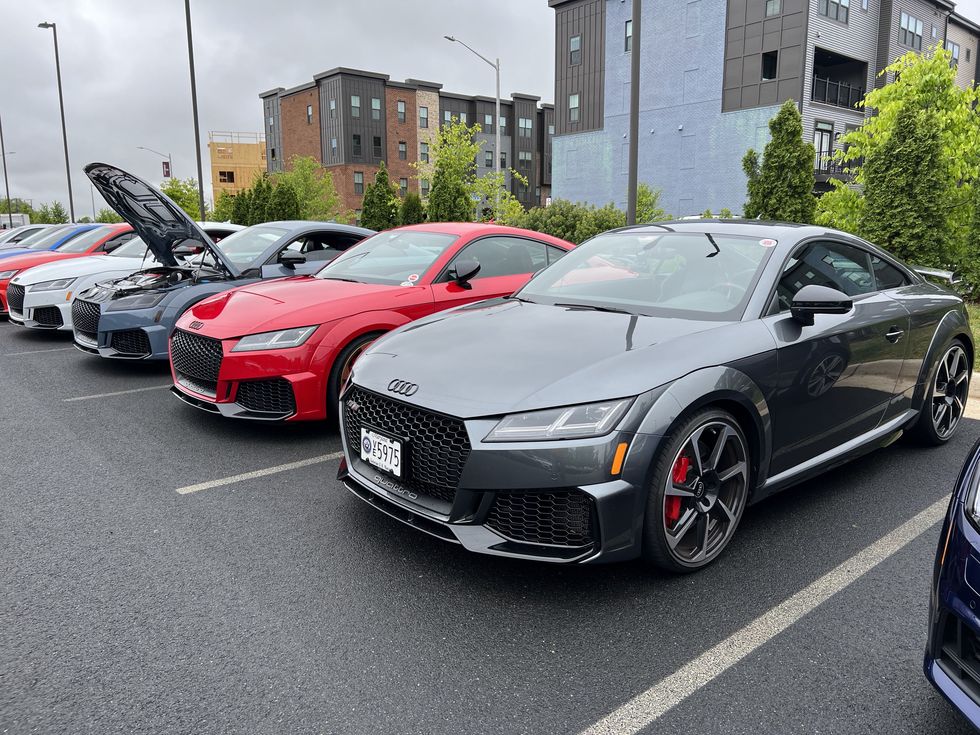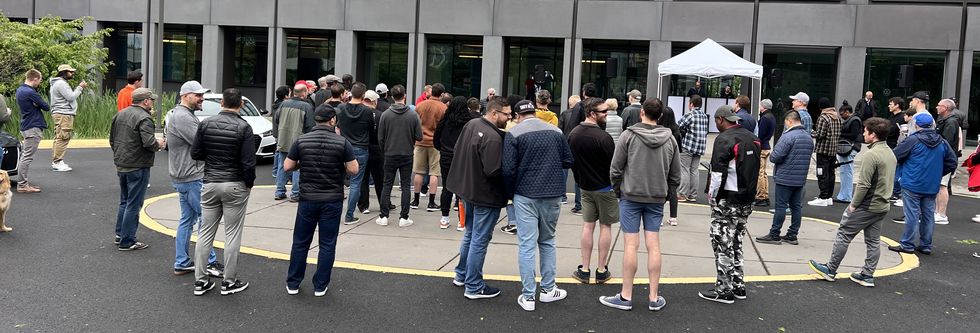Audi has seen the future and the TT isn’t in it. Neither is the R8, but that’s a story for another day. This past Saturday was all about the TT that’s leaving the German maker’s line and there’s nothing even remotely like it coming to take its place.
“In a data-driven market dominated by crossovers, cars like the Audi TT are a standout,” says George Achorn the President of the Audi Club of North America who drove his RS6 wagon to the TT celebration at VW’s stateside headquarters in Herndon, Virginia. “No focus group would have ever asked for it, but Audi led with style in launching the car and continued to improve on the model over time with aluminum chassis frame and five-cylinder turbocharged engines.” He’s biased, but he’s not wrong.
The TT entered production in 1998 as a 1999, and after the last few thousand 2023 models are sold, that’s it. Donezo. A 25 year run across three generations is no small feat. Other high-fashion specialty cars couldn’t manage it. Its corporate brother, the “New Beetle” introduced the year prior to the TT only made it through two generations and 22 years before its mercy killing in 2019. Chrysler (Stellantis or whatever), only got 10 years and a single generation of PT Cruisers out to dealers. And by time it was leaving production in 2010, its image had degenerated into a cultural joke. The TT never sold in huge numbers – no one expected it to – but by any reasonable standard, it had a great run.
It was overcast in the Washington D.C. area (of which Herndon is part) on Saturday, but no one seemed to care as they ate free apple cider doughnut bombs and drank some nutty and tasty locally-roasted coffee (also priced at nada).
“When it first launched, the (Mk1) TT was a rock star,” continued Achorn, “Audi’s first modern foray with the smaller transverse Volkswagen architecture, but paired with such high style and material quality that it still achieved showstopper status.“
The first generation TT is still a standout for being retro without aping any particular style. Squint some, and there’s a bit of 1937 Auto Union Type C or 1938 Type D Grand Prix cars in the first TT’s streamlined shape with no sharp edges. But the TT was never a revival of the glorious Silver Arrows that once shocked the racing world. Maybe there’s some Porsche 356 in it with a dash of VW This and DKW That. What the TT has always been is fun.
Running through Northern Virginia horse country with a new TT Roadster what’s instantly impressive is how solid the car feels. Not like a coupe with its rood hatcheted off, or a VW Golf that’s been rebodied to look like more than it truly is, but its own thing. A well-considered and well-engineered single ingot car.
The first generation TTs at the fiesta still look contemporary, even though many had headlight lenses fogged by age and some sagged a bit on their springs. They still look ready to romp.
Even the latest third generation TT is showing its age. This is one of the few current production vehicles that doesn’t have a massive display mounted atop its dash center. Instead, there are four round vents with ventilation controls cleverly embedded into their centers. Apple CarPlay and Android Auto and whatever AI that’s threatening to ruin civilization are displayed on the screen forward of the driver. That means it’s controlled by a click wheel and not by touching the screen. And it means the passenger can barely see it. But who cares? The driver’s fingers ought to be gripping the wheel instead of smudging a screen anyway.
Audi promises that the vehicles it’s making now with internal combustion engines are the best ever. And that the all-electric future will be surprising, delightful and not necessarily all SUVs. Maybe there’s a zaptastic TT revival to come. Here’s hoping.
“Though data may indicate the time for cars such as the TT has passed,” Achorn concludes, “I’d wager passion is what will continue to maintain cars as loved performance and style expressions rather than forgettable A-to-B transportation appliances.”
R&T will have more on the TT and R8 as they pass into history. For now, let’s simply acknowledge the loss. A loss that was easy to appreciate in a corporate parking lot, on an overcast Saturday, in Virginia.

Senior Editor
John Pearley Huffman has been writing about cars since 1990 and is getting okay at it. Besides Car and Driver, his work has appeared in the New York Times and more than 100 automotive publications and websites. A graduate of UC Santa Barbara, he still lives near that campus with his wife and two children. He owns a pair of Toyota Tundras and two Siberian huskies. He used to have a Nova and a Camaro.
Audi has seen the future and the TT isn’t in it. Neither is the R8, but that’s a story for another day. This past Saturday was all about the TT that’s leaving the German maker’s line and there’s nothing even remotely like it coming to take its place.
“In a data-driven market dominated by crossovers, cars like the Audi TT are a standout,” says George Achorn the President of the Audi Club of North America who drove his RS6 wagon to the TT celebration at VW’s stateside headquarters in Herndon, Virginia. “No focus group would have ever asked for it, but Audi led with style in launching the car and continued to improve on the model over time with aluminum chassis frame and five-cylinder turbocharged engines.” He’s biased, but he’s not wrong.
The TT entered production in 1998 as a 1999, and after the last few thousand 2023 models are sold, that’s it. Donezo. A 25 year run across three generations is no small feat. Other high-fashion specialty cars couldn’t manage it. Its corporate brother, the “New Beetle” introduced the year prior to the TT only made it through two generations and 22 years before its mercy killing in 2019. Chrysler (Stellantis or whatever), only got 10 years and a single generation of PT Cruisers out to dealers. And by time it was leaving production in 2010, its image had degenerated into a cultural joke. The TT never sold in huge numbers – no one expected it to – but by any reasonable standard, it had a great run.
It was overcast in the Washington D.C. area (of which Herndon is part) on Saturday, but no one seemed to care as they ate free apple cider doughnut bombs and drank some nutty and tasty locally-roasted coffee (also priced at nada).
“When it first launched, the (Mk1) TT was a rock star,” continued Achorn, “Audi’s first modern foray with the smaller transverse Volkswagen architecture, but paired with such high style and material quality that it still achieved showstopper status.“
The first generation TT is still a standout for being retro without aping any particular style. Squint some, and there’s a bit of 1937 Auto Union Type C or 1938 Type D Grand Prix cars in the first TT’s streamlined shape with no sharp edges. But the TT was never a revival of the glorious Silver Arrows that once shocked the racing world. Maybe there’s some Porsche 356 in it with a dash of VW This and DKW That. What the TT has always been is fun.
Running through Northern Virginia horse country with a new TT Roadster what’s instantly impressive is how solid the car feels. Not like a coupe with its rood hatcheted off, or a VW Golf that’s been rebodied to look like more than it truly is, but its own thing. A well-considered and well-engineered single ingot car.
The first generation TTs at the fiesta still look contemporary, even though many had headlight lenses fogged by age and some sagged a bit on their springs. They still look ready to romp.
Even the latest third generation TT is showing its age. This is one of the few current production vehicles that doesn’t have a massive display mounted atop its dash center. Instead, there are four round vents with ventilation controls cleverly embedded into their centers. Apple CarPlay and Android Auto and whatever AI that’s threatening to ruin civilization are displayed on the screen forward of the driver. That means it’s controlled by a click wheel and not by touching the screen. And it means the passenger can barely see it. But who cares? The driver’s fingers ought to be gripping the wheel instead of smudging a screen anyway.
Audi promises that the vehicles it’s making now with internal combustion engines are the best ever. And that the all-electric future will be surprising, delightful and not necessarily all SUVs. Maybe there’s a zaptastic TT revival to come. Here’s hoping.
“Though data may indicate the time for cars such as the TT has passed,” Achorn concludes, “I’d wager passion is what will continue to maintain cars as loved performance and style expressions rather than forgettable A-to-B transportation appliances.”
R&T will have more on the TT and R8 as they pass into history. For now, let’s simply acknowledge the loss. A loss that was easy to appreciate in a corporate parking lot, on an overcast Saturday, in Virginia.

Senior Editor
John Pearley Huffman has been writing about cars since 1990 and is getting okay at it. Besides Car and Driver, his work has appeared in the New York Times and more than 100 automotive publications and websites. A graduate of UC Santa Barbara, he still lives near that campus with his wife and two children. He owns a pair of Toyota Tundras and two Siberian huskies. He used to have a Nova and a Camaro.
Audi has seen the future and the TT isn’t in it. Neither is the R8, but that’s a story for another day. This past Saturday was all about the TT that’s leaving the German maker’s line and there’s nothing even remotely like it coming to take its place.
“In a data-driven market dominated by crossovers, cars like the Audi TT are a standout,” says George Achorn the President of the Audi Club of North America who drove his RS6 wagon to the TT celebration at VW’s stateside headquarters in Herndon, Virginia. “No focus group would have ever asked for it, but Audi led with style in launching the car and continued to improve on the model over time with aluminum chassis frame and five-cylinder turbocharged engines.” He’s biased, but he’s not wrong.
The TT entered production in 1998 as a 1999, and after the last few thousand 2023 models are sold, that’s it. Donezo. A 25 year run across three generations is no small feat. Other high-fashion specialty cars couldn’t manage it. Its corporate brother, the “New Beetle” introduced the year prior to the TT only made it through two generations and 22 years before its mercy killing in 2019. Chrysler (Stellantis or whatever), only got 10 years and a single generation of PT Cruisers out to dealers. And by time it was leaving production in 2010, its image had degenerated into a cultural joke. The TT never sold in huge numbers – no one expected it to – but by any reasonable standard, it had a great run.
It was overcast in the Washington D.C. area (of which Herndon is part) on Saturday, but no one seemed to care as they ate free apple cider doughnut bombs and drank some nutty and tasty locally-roasted coffee (also priced at nada).
“When it first launched, the (Mk1) TT was a rock star,” continued Achorn, “Audi’s first modern foray with the smaller transverse Volkswagen architecture, but paired with such high style and material quality that it still achieved showstopper status.“
The first generation TT is still a standout for being retro without aping any particular style. Squint some, and there’s a bit of 1937 Auto Union Type C or 1938 Type D Grand Prix cars in the first TT’s streamlined shape with no sharp edges. But the TT was never a revival of the glorious Silver Arrows that once shocked the racing world. Maybe there’s some Porsche 356 in it with a dash of VW This and DKW That. What the TT has always been is fun.
Running through Northern Virginia horse country with a new TT Roadster what’s instantly impressive is how solid the car feels. Not like a coupe with its rood hatcheted off, or a VW Golf that’s been rebodied to look like more than it truly is, but its own thing. A well-considered and well-engineered single ingot car.
The first generation TTs at the fiesta still look contemporary, even though many had headlight lenses fogged by age and some sagged a bit on their springs. They still look ready to romp.
Even the latest third generation TT is showing its age. This is one of the few current production vehicles that doesn’t have a massive display mounted atop its dash center. Instead, there are four round vents with ventilation controls cleverly embedded into their centers. Apple CarPlay and Android Auto and whatever AI that’s threatening to ruin civilization are displayed on the screen forward of the driver. That means it’s controlled by a click wheel and not by touching the screen. And it means the passenger can barely see it. But who cares? The driver’s fingers ought to be gripping the wheel instead of smudging a screen anyway.
Audi promises that the vehicles it’s making now with internal combustion engines are the best ever. And that the all-electric future will be surprising, delightful and not necessarily all SUVs. Maybe there’s a zaptastic TT revival to come. Here’s hoping.
“Though data may indicate the time for cars such as the TT has passed,” Achorn concludes, “I’d wager passion is what will continue to maintain cars as loved performance and style expressions rather than forgettable A-to-B transportation appliances.”
R&T will have more on the TT and R8 as they pass into history. For now, let’s simply acknowledge the loss. A loss that was easy to appreciate in a corporate parking lot, on an overcast Saturday, in Virginia.

Senior Editor
John Pearley Huffman has been writing about cars since 1990 and is getting okay at it. Besides Car and Driver, his work has appeared in the New York Times and more than 100 automotive publications and websites. A graduate of UC Santa Barbara, he still lives near that campus with his wife and two children. He owns a pair of Toyota Tundras and two Siberian huskies. He used to have a Nova and a Camaro.
Audi has seen the future and the TT isn’t in it. Neither is the R8, but that’s a story for another day. This past Saturday was all about the TT that’s leaving the German maker’s line and there’s nothing even remotely like it coming to take its place.
“In a data-driven market dominated by crossovers, cars like the Audi TT are a standout,” says George Achorn the President of the Audi Club of North America who drove his RS6 wagon to the TT celebration at VW’s stateside headquarters in Herndon, Virginia. “No focus group would have ever asked for it, but Audi led with style in launching the car and continued to improve on the model over time with aluminum chassis frame and five-cylinder turbocharged engines.” He’s biased, but he’s not wrong.
The TT entered production in 1998 as a 1999, and after the last few thousand 2023 models are sold, that’s it. Donezo. A 25 year run across three generations is no small feat. Other high-fashion specialty cars couldn’t manage it. Its corporate brother, the “New Beetle” introduced the year prior to the TT only made it through two generations and 22 years before its mercy killing in 2019. Chrysler (Stellantis or whatever), only got 10 years and a single generation of PT Cruisers out to dealers. And by time it was leaving production in 2010, its image had degenerated into a cultural joke. The TT never sold in huge numbers – no one expected it to – but by any reasonable standard, it had a great run.
It was overcast in the Washington D.C. area (of which Herndon is part) on Saturday, but no one seemed to care as they ate free apple cider doughnut bombs and drank some nutty and tasty locally-roasted coffee (also priced at nada).
“When it first launched, the (Mk1) TT was a rock star,” continued Achorn, “Audi’s first modern foray with the smaller transverse Volkswagen architecture, but paired with such high style and material quality that it still achieved showstopper status.“
The first generation TT is still a standout for being retro without aping any particular style. Squint some, and there’s a bit of 1937 Auto Union Type C or 1938 Type D Grand Prix cars in the first TT’s streamlined shape with no sharp edges. But the TT was never a revival of the glorious Silver Arrows that once shocked the racing world. Maybe there’s some Porsche 356 in it with a dash of VW This and DKW That. What the TT has always been is fun.
Running through Northern Virginia horse country with a new TT Roadster what’s instantly impressive is how solid the car feels. Not like a coupe with its rood hatcheted off, or a VW Golf that’s been rebodied to look like more than it truly is, but its own thing. A well-considered and well-engineered single ingot car.
The first generation TTs at the fiesta still look contemporary, even though many had headlight lenses fogged by age and some sagged a bit on their springs. They still look ready to romp.
Even the latest third generation TT is showing its age. This is one of the few current production vehicles that doesn’t have a massive display mounted atop its dash center. Instead, there are four round vents with ventilation controls cleverly embedded into their centers. Apple CarPlay and Android Auto and whatever AI that’s threatening to ruin civilization are displayed on the screen forward of the driver. That means it’s controlled by a click wheel and not by touching the screen. And it means the passenger can barely see it. But who cares? The driver’s fingers ought to be gripping the wheel instead of smudging a screen anyway.
Audi promises that the vehicles it’s making now with internal combustion engines are the best ever. And that the all-electric future will be surprising, delightful and not necessarily all SUVs. Maybe there’s a zaptastic TT revival to come. Here’s hoping.
“Though data may indicate the time for cars such as the TT has passed,” Achorn concludes, “I’d wager passion is what will continue to maintain cars as loved performance and style expressions rather than forgettable A-to-B transportation appliances.”
R&T will have more on the TT and R8 as they pass into history. For now, let’s simply acknowledge the loss. A loss that was easy to appreciate in a corporate parking lot, on an overcast Saturday, in Virginia.

Senior Editor
John Pearley Huffman has been writing about cars since 1990 and is getting okay at it. Besides Car and Driver, his work has appeared in the New York Times and more than 100 automotive publications and websites. A graduate of UC Santa Barbara, he still lives near that campus with his wife and two children. He owns a pair of Toyota Tundras and two Siberian huskies. He used to have a Nova and a Camaro.

